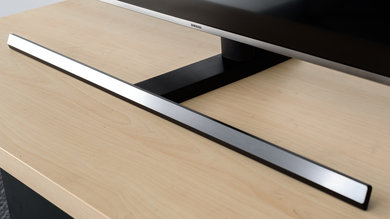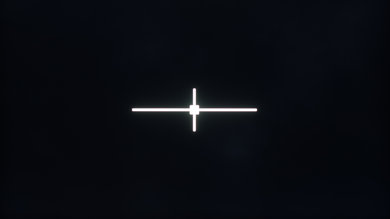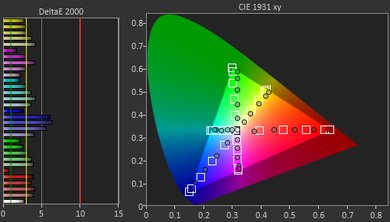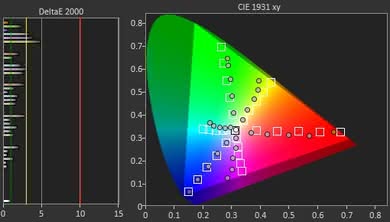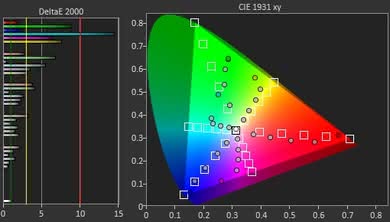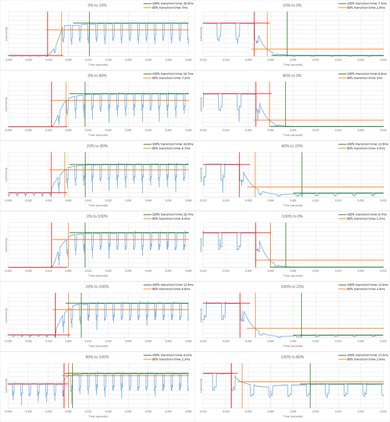The Samsung NU8000 is a versatile 4k LED TV with good picture quality and HDR support. It also has great motion handling, as only a short trail follows fast moving objects and the TV can flicker to clear up blur. The smart features also work well and the platform is intuitive. The TV includes the Bixby assistant for voice control. Unfortunately, the picture quality degrades when viewed at an angle and vertical blooming is visible in a completely dark room.
Our Verdict
Very good TV for mixed usage. Picture quality is good, but image loses accuracy when viewed at an angle. The TV can get bright to counteract glare in a bright room. Motion handling is great for watching sports, gaming or using it as a PC monitor. Dark scene performance is good, but the local dimming doesn't work well.
-
Great motion handling
-
Low input lag
-
Great SDR peak brightness
-
Colors appear washed out at an angle
Good for watching movies in a dark room. Picture quality is good, and colors accuracy is good out-of-the-box. The Samsung NU8000 can play most content without judder, which is great. Unfortunately, the local dimming doesn't work well to improve dark scene performance, as it reduces the brightness of small object significantly.
Very good for watching TV in a bright room. The TV can get bright across the whole screen to counteract glare, and reflection handling is good. The smart interface also works well for casual TV watching. Picture quality is good but degrades when viewed at an angle.
Good TV for sports fans. Motion handling is great, so fast-moving objects appear clear. Picture quality is good from directly in front but degrades when viewed at an angle. The TV can get bright to overcome glare in a bright room, and anti-reflection coating is good at diffusing direct lights on the screen.
Excellent TV for gamers. Picture quality is good when viewed from directly in front. Motion handling is great, so fast-moving objects remain clear. The Samsung NU8000 can also flicker the image to clear up fast motion, and input lag is very low which is excellent.
Good for watching HDR movies in a dark room. Picture quality is good and can produce more bright and vivid HDR highlights due to wide color gamut and high peak brightness. The TV can play most content without judder, which is great. Unfortunately, the local dimming doesn't work as well as some other TVs.
Great TV for HDR gaming on an Xbox One S or PS4 Pro. Picture quality is good, and motion handling is great due to the fast response time. The TV supports HDR features like a wide color gamut. The Samsung NU8000 also has a motion interpolation feature which works in game mode to produce smooth images with very little input lag which is great.
Great TV for PC use. The TV supports chroma 4:4:4 for clear text across all backgrounds. Picture quality is good but degrades when viewed at an angle so the sides of the screen can appear non-uniform from up close. Motion handling is great, and the TV feels responsive thanks to the very low input lag.
- 7.6 Mixed Usage
- 7.4 Movies
- 7.7 TV Shows
- 7.6 Sports
- 8.1 Video Games
- 7.3 HDR Movies
- 7.9 HDR Gaming
- 7.7 PC Monitor
- Updated May 21, 2020: Converted to Test Bench 1.5.
- Updated Feb 21, 2020: Converted to Test Bench 1.4.
- Updated Feb 28, 2019: Converted to Test Bench 1.3.
- Updated Jan 09, 2019: We have retested the BFI, and can confirm that the NU8000 can flicker at 120 Hz when displaying a 120 Hz signal. Scores updated.
- Updated Aug 14, 2018: Added the UK model numbers.
- Updated Jun 12, 2018: Retested peak brightness on firmware update 1103, and by sending the signal with our Samsung K8500 Blu-ray player. The brightness is now significantly higher, by around 60 cd/m². The score has been updated.
- Updated Jun 11, 2018: 1440p @ 120 Hz input lag has decreased as of firmware 1103. The review has been updated.
- Updated Jun 08, 2018: FreeSync has been tested and the scores have been updated.
- Updated May 23, 2018: Firmware version 1103 has added Freesync support. We are currently testing it and will update the review shortly.
- Updated May 02, 2018: The color gamut was erroneously measured at a 50% stimulus. It has been remeasured at 75% stimulus to be in line with our other TVs.
- Updated Mar 30, 2018: Review published.
- Updated Mar 28, 2018: Our testers have started testing this product.
- Updated Mar 28, 2018: Early access published.
- Updated Mar 26, 2018: The product has arrived in our lab, and our testers will start evaluating it soon.
- Updated Mar 22, 2018: We've purchased the product and are waiting for it to arrive in our lab.
Differences Between Sizes And Variants
We tested the 55" (UN55NU8000) version FA01. For the most part, we expect our review to be valid for the 49" version (UN49NU8000), 65" version (UN65NU8000), 75" version (UN75NU8000) and 82" version (UN82NU8000). Note that, like the MU8000, the 49" model has a 60Hz panel instead of the 120Hz panel found on other sizes.
There is an NU8070 variant that is available in the EU only. It is available in 49", 55", and 65". We're not sure what differences there are exactly, but Samsung markets the NU8070 as having "Supreme UHD Dimming", whereas the NU8000 in the E.U. is advertised with "UHD Dimming". It is interesting to note that the NU8000 in the U.S. is marketed with "Supreme UHD Dimming".
Warehouse stores in the U.S., including Sam's Club and Costco, carry the model code NU800D. As far as we know, it is the exact same TV, but there may be some very minor cosmetic differences.
If someone comes across a different type of panel or if their Samsung NU8000 doesn't correspond to our review, let us know and we will update the review. Note that the gray uniformity does vary on a unit-by-unit basis.
| Size | Model | US | UK | AU | Warehouse | Refresh Rate |
| 49" | UN49NU8000 | UN49NU8000FXZA | UE49NU8000FXZA | UN49NU800DFXZA | 60Hz | |
| 55" | UN55NU8000 | UN55NU8000FXZA | UE55NU8000FXZA | UA55NU8000WXXY | UN55NU800DFXZA | 120Hz |
| 65" | UN65NU8000 | UN65NU8000FXZA | UE65NU8000FXZA | UA65NU8000WXXY | UN65NU800DFXZA | 120Hz |
| 75" | UN75NU8000 | UN75NU8000FXZA | UE75NU8000FXZA | UA75NU8000WXXY | UN75NU800DFXZA | 120Hz |
| 82" | UN82NU8000 | UN82NU8000FXZA | UE82NU8000FXZA | UA82NU8000WXXY | UN82NU800DFXZA | 120Hz |
Compared To Other TVs

The Samsung NU8000 is a very good 4k TV without major flaws, but for different usages, there may be a better choice - especially considering the price premium of this 2018 model over comparable 2017 TVs. See our recommendations for the best 4k TVs, the best 65 inch TVs and the best TVs.
If you've got a room with wide seating and many lights, then the LG SK8000 is a better choice, but for a dark room with seating directly in front, then the Samsung NU8000 is better. The LG SK8000 has better viewing angles and reflection handling, whereas the Samsung NU8000 has better contrast, better black uniformity, and can get brighter. The Samsung NU8000 supports the FreeSync variable refresh rate to prevent tearing when playing video games and if you watch a lot of sports, you'll appreciate the Samsung's better gray uniformity.
The Samsung NU8000 is marginally better than the Samsung MU8000 for almost every usage. The Samsung NU8000 has slightly better input lag and includes the FreeSync variable refresh rate option, which is great if you play video games. Also, the Samsung NU8000 has marginally better SDR peak brightness and slightly better reflection handling. This allows you to place it in a brighter room where you can enjoy the casual watching of TV shows.
These two TVs were tested on different test benches, and the results aren't directly comparable. The Samsung NU8000 is a much newer TV that supports some of the latest gaming features like FreeSync VRR and low input lag with motion interpolation. The Samsung KS8000 has a higher contrast ratio and can deliver deep blacks to improve dark room performance. The two TVs have a similar picture quality and can get similarly bright. Both have a wide color gamut, so HDR content looks equally good.
The Samsung NU8000 is much better than the Samsung NU7100. The NU8000 is much brighter with all types of content. Motion is smoother as it can remove 24p judder from almost all sources, and the faster response time means less motion blur. The NU8000 also has some advanced gaming features, including automatic low latency mode and support for a variable refresh rate.
The Samsung NU8000 is much better than the Samsung TU8000. It has more features such as local dimming, support for variable refresh rate technology, and the ability to remove judder from all sources. It can also get much brighter and has better overall picture quality. On the other hand, the TU8000 has a somewhat improved contrast ratio and much better black uniformity.
The Samsung NU8000 is better than the Samsung NU7300. The NU8000 is much brighter and better able to overcome glare in a bright room. The NU8000 has a faster response time and can remove judder from most sources. The NU8000 also has new gaming features, including Auto Low Latency Mode and VRR (variable refresh rate).
The Samsung NU8000 is much better than the Samsung RU7100. The NU8000 has marginally faster response time, which is great for fast-moving content, and can get brighter, so it's more suitable for a brighter room. The Samsung NU8000 has local dimming support to help dark room performance and marginally better reflection handling, which is great if your room has many light sources. The NU8000 has a few gaming features not found on the RU7100, like FreeSync support. The Samsung RU7100 has a lower input lag, which is great for casual gaming.
The Samsung NU8000 is a bit better than the Samsung RU8000, although it's an older model that may be hard to find. The NU8000 has a local dimming feature that can improve dark room performance, whereas the RU8000 doesn't. The NU8000 can also get brighter in both SDR and HDR. That said, the RU8000 has a lower input lag and a faster response time, so it's better for gaming.
The Samsung Q9FN is much better than the Samsung NU8000. The Q9FN has a full array local dimming and more uniform blacks that help improve dark room performance. The Q9FN can get much brighter and handle bright room reflections better. The Samsung Q9FN has a wider color gamut and can deliver better HDR performance. The NU8000 has slightly lower input lag, which is great for video games.
The Samsung NU8000 is a bit better than the Samsung Q60R. It's much brighter, especially in HDR, and has better gray and black uniformity. The NU8000 has a local dimming feature, although this isn't very effective. The Q60R has a faster response time, great for gaming or watching fast action movies.
The Sony X900F is better than the Samsung NU8000. The X900F has a more advanced full array local dimming feature, whereas the NU8000 is edge-lit. The X900F has better motion handling, with a faster response time. The Samsung NU8000 is a bit better for competitive gaming, as it supports the latest technologies, including VRR and Auto Low Latency Mode, and it has less input lag.
The Samsung Q80/Q80R QLED TV is much better than the Samsung NU8000. The Q80 has a full array local dimming feature, which is great for dark room performance, whereas the NU8000 is edge-lit and its local dimming isn't good. The Q80 can also get significantly brighter, and has better viewing angles and better reflection handling.
The Samsung NU8000 is much better than the Samsung MU7600. The NU8000 is a much better gaming TV that has not only better response time and much lower input lag but is also packed with gaming features like FreeSync and black frame insertion. It's much better for watching movies in a dark room as it includes a local dimming feature to improve blacks and also has better black uniformity. Finally, the NU8000 has better brightness and better reflection handling. The Samsung MU7600 is curved, and this can attract some who wish to use it as a PC monitor.
The Samsung NU8500 is the curved version of the Samsung NU8000. The overall performance of both TVs is very similar, and measured differences may be due to panel variance.
The Samsung Q70/Q70R QLED is better than the Samsung NU8000. The Q70R has better dark room performance, thanks to its full-array local dimming, higher contrast ratio, and better black uniformity. The Q70R can display judder-free movies from any source and has a lower input lag, which is great for playing video games. The Samsung NU8000 can get slightly brighter, which is apparent when watching in a well-lit room, and has a little better gray uniformity, so there's less dirty screen effect.
The LG C8 is much better than the Samsung NU8000. The LG C8 has perfect blacks that improve the picture quality significantly in a dark room. Also, the LG C8 has better reflection handling and better viewing angles and is suitable for a large room with many windows. On the other hand, the Samsung NU8000 doesn't have a risk of permanent burn-in, can get the whole screen brighter, and has lower input lag. It also supports the FreeSync implementation of the variable refresh rate, which is excellent if you play video games.
If you've got a room with wide seating and several light sources, then the LG SK9000 is a better choice as it has better viewing angles and better reflection handling. Although its local dimming algorithm is better than the Samsung's, it can't display deep blacks in a dark room due to the IPS panel. So for a dark room with seating directly in front, the Samsung NU8000 is a better choice. The better contrast ratio and black uniformity allow for deeper blacks and offer a better movie experience. Also, the Samsung NU8000 is equipped with the FreeSync variable refresh rate technology to eliminate tearing when you play video games.
These two TVs have different panel types. For a room with a wide seating arrangement, the LG UK6300 might be a better choice if you'll often be watching TV from the side. However, the Samsung NU8000 is a much better choice if you'll be watching from straight in front. It can get much brighter to fight glare and can also display deeper blacks thanks to its high native contrast ratio. The NU8000 has better gray uniformity and faster response time which makes it great for watching sports. Finally, the NU8000 has FreeSync support and low input lag with motion interpolation, which is great if you are a gamer.
These two TVs have different panel types. If you've got a room with a wide sitting arrangement, then the Sony X800E is a better choice as the image remains accurate when viewed from the side. If you'll be sitting straight in front and like watching movies in a dark room, then the Samsung NU8000 is a better option as it can deliver deeper and more uniform blacks. Also, the NU8000 supports FreeSync variable refresh rate technology which helps prevent tearing when playing video games.
The Samsung NU8000 is much better than the Samsung NU6900. The Samsung NU8000 is a better TV for gaming thanks to the lower input lag, FreeSync support, and low input lag with motion interpolation. The Samsung NU8000 can get brighter both in SDR and in HDR and has a wide color gamut that enhances HDR performance. The Samsung NU8000 has a faster response time, and only a small blur trail is visible behind fast-moving content. Finally, the Samsung NU8000 is a better choice for use as a PC monitor.
The Samsung NU8000 is much better than the Samsung RU7300. The NU8000 can get brighter and can handle bright room reflections better. The NU8000 also delivers a better dark room performance thanks to its local dimming feature, and motion looks crisper on the NU8000 due to the faster response time. The Samsung RU7300 is a curved TV that delivers a little lower input lag, which matters for video games.
The Samsung NU8000 and the TCL 6 Series (R617) have very similar performance. The TCL R617 has better local dimming performance, so blacks look deep in a dark room and better HDR peak brightness that makes highlights pop in HDR content. The Samsung NU8000, on the other hand, supports FreeSync variable refresh rate which can eliminate tearing if you play video games. Finally, the Samsung NU8000 has better gray uniformity, so the image is free from clouding or shadows in slow panning uniform-color shots like a hockey arena or a soccer field.
The Samsung NU8000 and the LG SM8600 use different panel technologies, each with their strengths and weaknesses. The NU8000 has a much better dark room performance, provided you sit directly in front of it. The LG SM8600 is a better choice for a room with a wide seating arrangement. Apart from these differences, the NU8000 is brighter but has worse reflection handling.
These two TVs are very different. However, most people will agree that the Samsung NU8000 is much better than the LG UK6570 overall. The LG has an IPS panel and is more suitable for a room with a wide seating arrangement, thanks to its better viewing angles. The Samsung, on the other hand, has better dark room performance, provided you sit right in front. The Samsung NU8000 can also get brighter to fight glare and has a few gaming goodies like FreeSync support and auto low latency.
These are two different types of TVs. If you have a large room with a wide seating arrangement, then Sony X750F is a better choice as the image remains accurate when viewed from the side. If, however, you sit straight in front and like watching movies in a dark room, then the Samsung NU8000 is a better choice as it can display deeper and more uniform blacks and can remove 24p judder from any source. The Sony X750F is flicker-free, which is great if you're sensitive to flicker, but the Samsung NU8000 is better for playing video games as it supports FreeSync and has a lower input lag. Finally, the Samsung NU8000 can get brighter both in SDR and in HDR.
The Samsung NU8000 is a bit better than the Samsung The Frame 2018. The NU8000 is a lot brighter, and small highlights stand out better in HDR due to the higher peak brightness. The Frame has the separate One Connect box, whereas the NU8000's inputs are all out to the side.
The Samsung NU8000 is better than the Hisense H9E Plus. The NU8000 is much brighter in SDR and can overcome glare in a bright room. The NU8000 is a lot brighter in HDR and bright highlights stand out better. The NU8000 is more feature-packed than the H9E Plus; it can reduce the backlight flicker to improve motion clarity and it supports VRR and auto low latency mode, perfect for gamers.
The Samsung NU8000 is a bit better than the Sony X830F. The Samsung NU8000 has better native contrast ratio and local dimming support, which produce deep blacks in a dim room and offer you a very good movie and HDR movie experience. The Samsung can also get brighter and can handle reflections slightly better, so it's more suitable than the Sony for a brighter room. Finally, the Samsung NU8000 is better for gaming due to the lower input lag and FreeSync support. The Sony X830F has a faster response time and will leave a smaller blur trail in fast-moving content like sports.
The LG B8 is significantly better than the Samsung NU8000. The LG B8 has perfect blacks and delivers an excellent movie-watching experience. It also has wider viewing angles and better reflection handling than the Samsung and is a better choice for wide seating arrangements or rooms with many light sources. The B8 also has a faster response time resulting in less blur when watching fast content. The Samsung NU8000 supports the FreeSync VRR implementation to help avoid tearing and also has lower input lag, which is great if you play video games.
If you have a room with a wide seating arrangement, then the LG UK7700 is a better choice as the image remains accurate when viewed at an angle. If, however, you sit straight in front of the TV and watch movies in a dark room, then the Samsung NU8000 is a much better choice as it has a higher contrast ratio and can display deep uniform blacks, enhancing the picture quality. The Samsung NU8000 can get brighter to fight bright room glare and supports FreeSync for tear-free gaming sessions. The LG UK7700 has better reflection handling and a lower input lag, which is great for playing video games.
If you've got a bright room with wide seating, then the LG SK9500 is a better choice as it has better viewing angles and can handle reflections better and this is important when watching sports or TV shows. For a dark room, however, with seating directly in front, the Samsung NU8000 is better. The better contrast ratio and better black uniformity allow it to display deeper blacks in a dark room and thus you'll enjoy movies and HDR movies more on the Samsung NU8000. Finally, it supports FreeSync VRR, which is great for gamers.
The Vizio P Series 2018 is better than the Samsung NU8000. The Vizio P Series has a more advanced full-array local dimming system that produces better blacks and delivers better dark room performance, as well as helping highlights to stand out in HDR. The P Series has smoother motion, since the response time is much faster, great for gaming or fast action scenes. The Samsung NU8000 has some gaming-oriented features, including VRR and automatic game mode.
The overall performance of the Samsung Q6FN and the Samsung NU8000 is very similar, but the Q6FN is slightly better across the board. The differences are marginal, though.
The Samsung Q8FN is better than the Samsung NU8000. The Samsung Q8FN has full array local dimming and can deliver a better dark room performance. Also, the Samsung Q8FN can handle reflections better, thus minimizing distractions.
The Samsung Q7FN is better than the Samsung NU8000. The Samsung Q7FN has much better reflection handling so you can easily place it in a bright room with many windows. The Q7FN performs better in HDR as it can get brighter and has a wider color gamut that allows it to display rich and saturated colors with highlights that pop. Finally, the Samsung Q7FN has a slightly better black frame insertion feature which helps clear the image from motion blur.
If you enjoy watching movies or playing games in a dark room with seating right in front, then the Samsung NU8000 is a better choice; however, if you have a large bright room with wide seating, then the Sony X850F is a better choice due to the better viewing angles and better reflection handling. The Samsung NU8000, on the other hand, is much better for watching movies as it has better blacks in a dark room. It's also much better for gaming due to lower input lag, faster response time, and FreeSync variable refresh rate technology.
If you watch TV in a dark room with seating directly in front, then the Samsung NU8000 is a better choice than the LG SJ8500. It has significantly better black uniformity and contrast that allow it to display deep blacks thus improving picture quality. The Samsung NU8000 also has better SDR peak brightness, which is good for TV shows in brighter rooms. When it comes to gaming, the Samsung NU8000 has a better response time, it incorporates the FreeSync VRR technology, and has slightly better black frame insertion (BFI) to sharpen the image. On the other hand, the LG SJ8500 has somewhat better viewing angles, suitable for wide seating and better reflection handling for those rooms with a lot of windows.
The Samsung MU9000 and the Samsung NU8000 have very similar performance. The Samsung MU9000 has somewhat better reflection handling, which is great if you have a bright room with many windows. The Samsung NU8000 has a better back uniformity and delivers better dark room performance. It also has FreeSync support and lower input lag, which is great for playing video games.
The Sony X900E is better than the Samsung NU8000 for most people, unless your main usage is for gaming. The Sony X900E has a better local dimming feature and better reflection handling, making it better suited to a wider variety of viewing conditions. The Samsung NU8000 has lower input lag across all resolutions and supports AMD's FreeSync Variable Refresh Rate technology, making it a better choice for gamers.
The Samsung NU8000 is a bit better than the Samsung Q7F 2017. The Samsung can get brighter and is more suitable for a bright room. It also has better black uniformity, which improves dark room performance. The Q7F, on the other hand, can handle reflections a little better and has a faster response time that delivers crisper moving content.
Video
Test Results
The design of the Samsung NU8000 is excellent. Compared to the MU8000, the new stand feels very solid and has a slightly smaller footprint, although if you were planning on using a soundbar in front of the TV, you might have to make some concessions. There are new cable management guides cut into the back. The TV does not include the mini OneConnect box, all of the connections are towards the side of the TV.
The back of the TV has a textured finish very similar to last year's MU8000. It has new tracks for cable management that are cut the entire width of the back of the TV. The VESA wall mount is 200x200 instead of the 400x400 found on most of last year's models .
The NU8000 has slightly larger borders than last year's MU8000. The finish of the main bezel has changed from silver to black.
The TV is quite thin when viewed from the side, although it is slightly thicker than last year's MU8000.
When wall mounted, the TV doesn't stick out much which is good. The lack of the OneConnect mini means you will have more work if you need to change the connections, but you don't have to worry about where to place the box.
The overall build quality is average, nearly identical to the MU8000. It is almost entirely made of plastic but feels solid. We haven't experienced any quality issues.
Update 07/31/2018: A few readers are reporting a clicking sound issue. From our investigation it seems to come from heat expansion of the back cover. We think that once the TV is warm enough it should settle down.
Excellent native contrast ratio on the Samsung NU8000, approximately 15% better than the MU8000. This high contrast ratio allows the TV to produce deep black scenes, especially when viewing in a dark room.
The local dimming feature has very little impact on the contrast ratio. This is to be expected as the local dimming on this edge-lit TV is not very effective at making blacks deeper.
The local dimming on the NU8000 is bad. It dims the screen less than the MU8000, but focuses the dimming on moving highlights as it should. This helps reduce the amount of visible blooming and the black levels appear raised.
Great SDR peak brightness. In dark scenes, the TV tries to keep black levels low rather than favoring brighter highlights. Brightness remains consistent, regardless of content and the TV is bright enough for most rooms.
Update 06/12/2018: Retested peak brightness on firmware update 1103, and by sending the signal with our Samsung K8500 Blu-ray player. The brightness is now significantly higher, by around 60 cd/m². The score has been updated.
Decent HDR peak brightness, slightly better than last year's MU8000 but significantly dimmer than the X900F. It is able to produce brief bright highlights especially in the 2% - 10% range. Bright enough for almost all rooms.
Update 06/12/2018: Retested peak brightness on firmware update 1103, and by sending the signal with our Samsung K8500 Blu-ray player. The brightness is now significantly higher, by around 60 cd/m². The score has been updated.
Good gray uniformity. The uniformity issues appear mainly around the edges of the screen. As such, the TV's dirty screen effect is not problematic when watching sports or playing games.
Dark scene uniformity is very good. The edges appear slightly brighter than the center but should not be noticeable.
Poor viewing angle. Colors and brightness shift if you are even slightly off center. The side seats of a 3 seat couch will notice a small difference, but people sitting further off center than that will have degraded picture quality. If viewing angle is an issue, an IPS panel like in the X800E would be a better choice.
Black uniformity is very good on the NU8000. No clouding can be seen with or without local dimming. Standard deviation is much better than last year's MU8000, and this year's X900F, which results in uniform dark scenes without distracting areas.
Like the MU8000, it is impossible to completely disable local dimming on this TV. As such, it is impossible to determine the true native black uniformity performance of this TV. We ran our test with the local dimming feature set to 'Low' (the lowest setting). The test for black uniformity with local dimming was taken with local dimming set to 'High'.
The TV reflects a lot of light, but not as bad as other models we have tested like the MU8000. The semi-gloss finish diffuses reflections across most of the screen although there are no visible rainbows.
Good color accuracy out of the box, but follows our target of 6500K and 2.2 gamma much worse than last year's MU8000. White balance has too much red/green and gamma is too high across the entire curve at 2.42. The color temperature is cold at 6032K giving colors more of a yellow tint.
Update 04/12/2019: This TV was incorrectly measured with Brightness +2, instead of at 0. This only has a small impact on the results (slightly dimmer dark scenes below about 30 IRE) and so we don't plan to retest it.
White balance and color temperature are near perfect post calibration. We were unable to correct color accuracy, although it remains acceptable for most people. We obtained the best results in the 'Movie' picture mode.
You can see our recommended settings here.
Good color gamut on the Samsung NU8000, slightly better than the MU8000. Colors in HDR will be fairly accurate, although the TV has difficulty displaying deep greens. Very similar results to the Sony X900E.
The 'Movie' picture mode's HDR EOTF follows the target PQ curve very well, up until it rolls off into its max brightness. 'Game' and 'PC' modes also have fairly accurate EOTFs. In 'PC' mode the 'Dynamic' picture mode has the best HDR EOTF, because 'Standard' mode has a bug where it sometimes gets stuck in a dim state. *Corrected, see below.
Update 05/02/2018: The color gamut was erroneously measured at a 50% stimulus. It has been remeasured at 75% stimulus to be in line with our other TVs. The results remain almost identical.
Update 11/07/2018: The bug with the PC mode EOTF mentioned earlier was a mistake, it turns out the TV's 'Eco' mode was left on in PC mode accidentally (the PC mode setting is independent of the normal one). The PC mode EOTF has been remeasured in the 'Standard' picture mode, and isn't quite as good as the 'Movie' mode EOTF (darkens dim shades a little), but is still pretty good.
Decent color volume. It does a better job than the MU8000 at displaying bright colors across its entire color gamut, but still does not display deep, dark colors very well.
There is no measurable temporary image retention on the NU8000, even immediately after the burn-in scene. This is good, especially for gamers.
We don't expect VA panels to experience permanent image retention, as the VA panel in our long-term test appears immune.
The TV dims its backlight by using PWM flicker at 240 Hz. This flicker is unfortunately present at all brightness levels but is less severe at high brightness. This flicker makes fast motion look a little more clear, but also introduces unwanted duplications, as visible in the photo in the Response Time box.
The Samsung NU8000 has an optional 60 Hz flicker mode, activated by enabling 'LED Clear Motion' in the 'Auto Motion Plus' menu. This 60 Hz flicker greatly clears up motion during 60 fps content, but the flicker can be bothersome to some people. This flicker can also be activated in Game mode, by using the 'Game Motion Plus' menu, which is a first for Samsung TVs.
Update 01/09/2019: We have retested the backlight flicker at 120 Hz, and can confirm that the NU8000 does flicker at 120 Hz when displaying a 120 Hz signal.
The Samsung 55NU8000 has a 120 Hz panel, and can interpolate lower frame rate content up to 120 fps. This makes motion much smoother, but can look strange to some people (the so-called 'soap opera effect'), and sometimes adds unwanted artifacts during fast motion. Interpolation is activated by setting 'Auto Motion Plus' to 'Custom'; increase the 'Judder Reduction' slider to interpolate low frame rate content, and increase the 'Blur Reduction' slider to interpolate 60 fps content.
Game mode now also has motion interpolation, 'Game Motion Plus', which doesn't look as good as 'Auto Motion Plus' but adds much less input lag, as explained in the Input Lag box.
The TV is decent at showing smooth motion in low frame rate content like movies, however, its fast response time can sometimes make motion look stuttery, such as in wide panning shots, because each frame stays unchanged for 29 ms.
The 55NU8000 can remove 24p movie judder from most sources, except 60i input such as cable boxes; this is a regression from last year's Samsung TVs, which could remove judder from all common sources. To activate judder removal, set 'Auto Motion Plus' to 'Custom', 'Judder Reduction' to 0 and 'Blur Reduction' to 0; this will remove judder without adding soap opera effect.
The NU8000 does not support FreeSync from our Radeon RX 580 GPU. We tried various combinations of game mode, PC mode, input refresh rates, etc., and FreeSync was never detected as supported.
Update 05/23/2018: Firmware version 1103 has added FreeSync support.
Update 06/08/2018: FreeSync has been tested and the score has been updated. FreeSync was supported from our Xbox One S and our Radeon RX 580 GPU, in 1080p, 1440p and 4k resolutions. FreeSync is activated by enabling the TV's Game mode and FreeSync settings; PC mode is not required. We tested in Ultimate mode because it has the widest range, and we only recommend Basic mode when you experience problems with Ultimate.
Update 10/26/2018: We have received confirmation that the 49" NU8000 does support FreeSync. Since it has a 60 Hz panel, the 1080p VRR range is limited to 60 Hz.
1440p @ 120 Hz: 9.7 ms
Excellent low input lag, good enough for even competitive console gaming. This input lag is lower than last year's Samsung TVs like the MU8000, and lower than many current Sony TVs like the X900F, but is slightly worse than many TCL TVs like the P607.
The NU8000 has a new 'Game Motion Plus' feature, which adds motion interpolation (soap opera effect) without adding too much input lag; this feature is useful when gaming on older consoles that can only output 30 fps, or for games that have frequent framerate dips. The 'Judder Reduction' slider interpolates content up to 60 fps, while the 'Blur Reduction' slider interpolates up to 120 fps. When 'Blur Reduction' is used the input lag for 4k increases from 23.8 ms to 29.3 ms, but this increase shouldn't be noticeable during gaming.
Update 04/24/2018: The NU8000 and the Samsung 2018 QLEDs added support for Auto Game Mode. When it is enabled from the input menu the TV will automatically switch to Game Mode when it detects a game being played on a console. We tested it on a PS4 and Xbox One S and it worked perfectly.
Update 06/08/2018: The input lag with VRR has been tested and added to the review.
Update 06/11/2018: 1440p @ 120 Hz performance has improved as of firmware version 1103. The 1440p @ 120 Hz input lag is now 9.7 ms, down from 24.8 ms.
Most common resolutions are supported. 4k @ 60 Hz @ 4:4:4 or 4:2:2 color is only supported when 'HDMI UHD Color' is enabled (aka HDMI 2.0 full bandwidth). New this year is 1080p @ 120 Hz @ 4:4:4 support, which is useful when using the TV as a PC monitor. 1440p @ 120 Hz is also supported, but 4:4:4 color isn't displayed properly. Oddly enough, 1440p @ 60 Hz isn't supported, not even when using a custom resolution from a PC.
4:4:4 chroma subsampling is only shown properly when the input's icon is set to 'PC' (aka PC mode). This unfortunately isn't possible for some input refresh rates such as 24 Hz; in these cases the icon changes to PC as normal but PC mode isn't applied, as evidenced by the improper 4:4:4 color resolution and some settings not being greyed out as they should be.
The NU8000 does not support DTS passthrough, unlike last year's Samsung TVs. This is not usually an issue though since most media provides both DTS and Dolby Digital sound streams.
The frequency response of the NU8000 is decent, and very similar to the 2017 model the MU8000. The LFE (low-frequency extension) is at 67Hz, which is good and lower than what most TVs are able to reach. This means that the TV should be able to produce a decent amount of bass and punch. However, due to the lack of a self-calibrating system, it wasn't able to remove the room buildup around 200Hz. The response in the mid and treble ranges are quite even and flat, ensuring a neutral sound reproduction. Additionally, the maximum loudness of the TV is above-average, but they may produce some pumping and compression artifacts under maximum load.
The harmonic distortion performance is about average. The overall amount of THD is rather elevated, but on there doesn't seem to be a dramatic rise in THD under maximum load. However, the sharp peaks around 1KHz and 2KHz, could the make the sound of those frequencies a bit harsh and brittle.
The TV's interface is well organized and easy to navigate. The Smart Hub is the center of the interface and must be passed through to access everything else, which can take more time than going directly. Animations in the interface rarely lag but are frequently choppy and full of frame drops, even worse than on last year's TVs like the Q7F.
Samsung's app store has one of the largest app selections of any smart platform, though not quite as large as Android's Google Play Store. App themselves run fairly smoothly, even smoother than the TV's own interface.
Samsung's smart remote is fairly small and has few buttons, requiring users to either navigate through the home menu to access things, or to use Samsung's Bixby voice assistant feature. Bixby's voice recognition works very well, and it can perform many useful actions on the TV: commands like 'Change to HDMI 1', 'Set backlight to 25', 'What's the weather like tomorrow', and 'Pause video' all work well. Samsung's smart remote can also act as a universal remote for other devices, even devices that don't support HDMI CEC, using Samsung's OneRemote feature.


